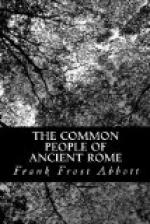It is only when the general passion for setting down records of all sorts of enterprises and incidents on imperishable materials came in with the Empire that the story of the Roman trades-union can be clearly followed. It is a fortunate thing for us that this mania swept through the Roman Empire, because it has given us some twenty-five hundred inscriptions dealing with these organizations of workmen. These inscriptions disclose the fact that there were more than eighty different trades organized into guilds in the city of Rome alone. They included skilled and unskilled laborers, from the porters, or saccarii, to the goldsmiths, or aurifices. The names of some of them, like the pastillarii, or guild of pastile-makers, and the scabillarii, or castanet-players, indicate a high degree of industrial specialization. From one man’s tombstone even the conclusion seems to follow that he belonged to a union of what we may perhaps call checker-board makers. The merchants formed trade associations freely. Dealers in oil, in wine, in fish, and in grain are found organized all over the Empire. Even the perfumers, hay-dealers, and ragmen had their societies. No line of distinction seems to be drawn between the artist and the artisan. The mason and the sculptor were classed in the same category by Roman writers, so that we are not surprised to find unions of men in both occupations. A curious distinction between the professions is also brought out by these guild inscriptions. There are unions made up of physicians, but none of lawyers, for the lawyer in early times was supposed to receive no remuneration for his services. In point of fact the physician was on a lower social plane in Rome than he was even among our ancestors. The profession was followed almost exclusively by Greek freedmen, as we can see from the records on their tombstones, and was highly specialized, if we may judge from the epitaphs of eye and ear doctors, surgeons, dentists, and veterinarians. To the same category with the physician and sculptor belong the architect, the teacher, and the chemist. Men of these professions pursued the artes liberales, as the Romans put it, and constituted an aristocracy among those engaged in the trades or lower professions. Below them in the hierarchy came those who gained a livelihood by the artes ludicrae, like the actor, professional dancer, juggler, or gladiator, and in the lowest caste were the carpenters, weavers, and other artisans whose occupations were artes vulgares et sordidae.




